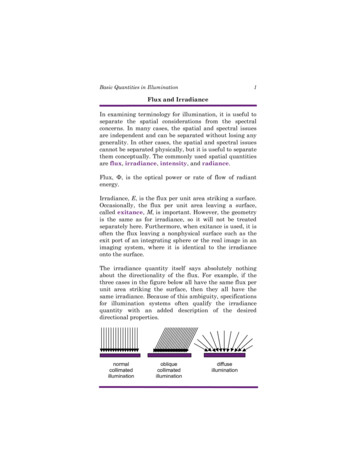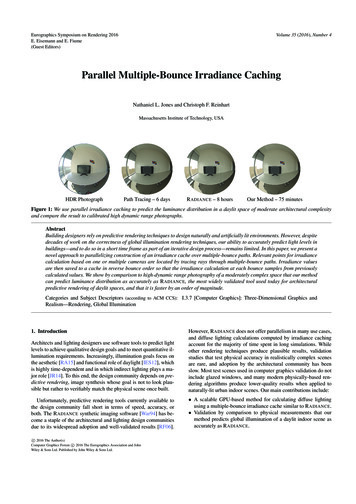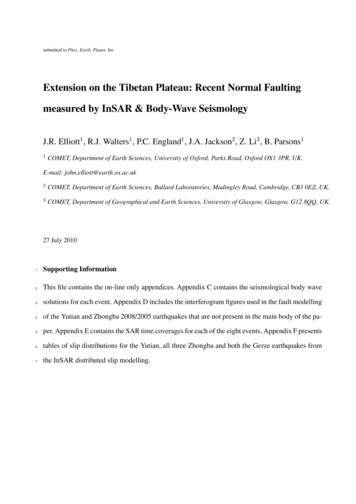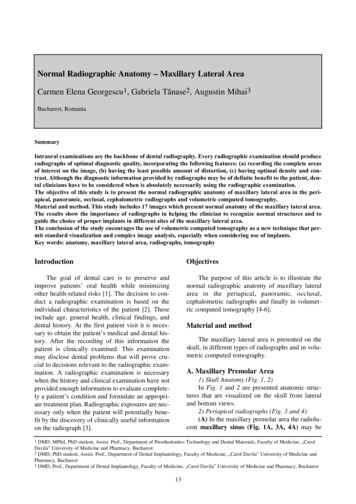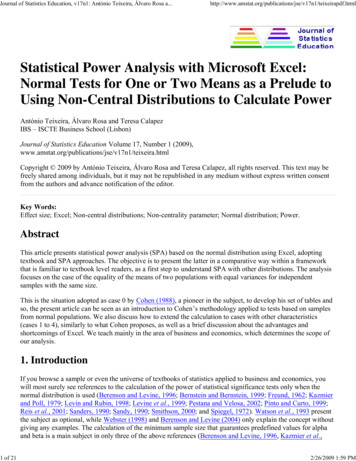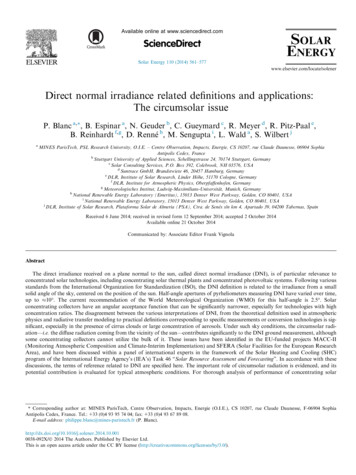
Transcription
Available online at www.sciencedirect.comScienceDirectSolar Energy 110 (2014) 561–577www.elsevier.com/locate/solenerDirect normal irradiance related definitions and applications:The circumsolar issueP. Blanc a, , B. Espinar a, N. Geuder b, C. Gueymard c, R. Meyer d, R. Pitz-Paal e,B. Reinhardt f,g, D. Renné h, M. Sengupta i, L. Wald a, S. Wilbert jaMINES ParisTech, PSL Research University, O.I.E. – Centre Observation, Impacts, Energie, CS 10207, rue Claude Daunesse, 06904 SophiaAntipolis Cedex, FrancebStuttgart University of Applied Sciences, Schellingstrasse 24, 70174 Stuttgart, GermanycSolar Consulting Services, P.O. Box 392, Colebrook, NH 03576, USAdSuntrace GmbH, Brandstwiete 46, 20457 Hamburg, GermanyeDLR, Institute of Solar Research, Linder Höhe, 51170 Cologne, GermanyfDLR, Institute for Atmospheric Physics, Oberpfaffenhofen, GermanygMeteorologisches Institut, Ludwig-Maximilians-Universität, Munich, GermanyhNational Renewable Energy Laboratory (Emeritus), 15013 Denver West Parkway, Golden, CO 80401, USAiNational Renewable Energy Laboratory, 15013 Denver West Parkway, Golden, CO 80401, USAjDLR, Institute of Solar Research, Plataforma Solar de Almeria (PSA), Ctra. de Senés s/n km 4, Apartado 39, 04200 Tabernas, SpainReceived 6 June 2014; received in revised form 12 September 2014; accepted 2 October 2014Available online 21 October 2014Communicated by: Associate Editor Frank VignolaAbstractThe direct irradiance received on a plane normal to the sun, called direct normal irradiance (DNI), is of particular relevance toconcentrated solar technologies, including concentrating solar thermal plants and concentrated photovoltaic systems. Following variousstandards from the International Organization for Standardization (ISO), the DNI definition is related to the irradiance from a smallsolid angle of the sky, centered on the position of the sun. Half-angle apertures of pyrheliometers measuring DNI have varied over time,up to 10 . The current recommendation of the World Meteorological Organization (WMO) for this half-angle is 2.5 . Solarconcentrating collectors have an angular acceptance function that can be significantly narrower, especially for technologies with highconcentration ratios. The disagreement between the various interpretations of DNI, from the theoretical definition used in atmosphericphysics and radiative transfer modeling to practical definitions corresponding to specific measurements or conversion technologies is significant, especially in the presence of cirrus clouds or large concentration of aerosols. Under such sky conditions, the circumsolar radiation—i.e. the diffuse radiation coming from the vicinity of the sun—contributes significantly to the DNI ground measurement, althoughsome concentrating collectors cannot utilize the bulk of it. These issues have been identified in the EU-funded projects MACC-II(Monitoring Atmospheric Composition and Climate-Interim Implementation) and SFERA (Solar Facilities for the European ResearchArea), and have been discussed within a panel of international experts in the framework of the Solar Heating and Cooling (SHC)program of the International Energy Agency’s (IEA’s) Task 46 “Solar Resource Assessment and Forecasting”. In accordance with thesediscussions, the terms of reference related to DNI are specified here. The important role of circumsolar radiation is evidenced, and itspotential contribution is evaluated for typical atmospheric conditions. For thorough analysis of performance of concentrating solar Corresponding author at: MINES ParisTech, Centre Observation, Impacts, Energie (O.I.E.), CS 10207, rue Claude Daunesse, F-06904 SophiaAntipolis Cedex, France. Tel.: 33 (0)4 93 95 74 04; fax: 33 (0)4 93 67 89 08.E-mail address: philippe.blanc@mines-paristech.fr (P. .0010038-092X/Ó 2014 The Authors. Published by Elsevier Ltd.This is an open access article under the CC BY license (http://creativecommons.org/licenses/by/3.0/).
562P. Blanc et al. / Solar Energy 110 (2014) 561–577systems, it is recommended that, in addition to the conventional DNI related to 2.5 half-angle of today’s pyrheliometers, solar resourcedata sets also report the sunshape, the circumsolar contribution or the circumsolar ratio (CSR).Ó 2014 The Authors. Published by Elsevier Ltd. This is an open access article under the CC BY license ords: Direct normal irradiance; Circumsolar irradiance; Circumsolar ratio; Pyrheliometer; Concentrating solar technologiesNomenclatureACRAODCOSTactive cavity radiometeraerosol optical depthEuropean cooperation in science andtechnologyCPVconcentrating photovoltaicCSNIcircumsolar normal irradianceCSPconcentrating solar powerCSRcircumsolar ratioCSTconcentrating solar technologiesDNIdirect normal irradianceIEAInternational Energy AgencyLBNLLawrence Berkeley National LaboratoryMACCMonitoring Atmospheric Compositionand ClimateMYSTICMonte Carlo for the physically correcttracing of photons in cloudy atmospheresOPACoptical properties of aerosols and cloudsPVPSphotovoltaic power systemsRSIrotating shadowband irradiometerSAMsolar (or system) advisor modelSFERASolar Facilities for the European Research AreaSHCSolar Heating and CoolingSMARTSsimple model of the atmospheric radiativetransfer of sunshineSODslant optical depthSolarPACES solar power and chemical energy systemsWIREweather intelligence for renewable energyWMOWorld Meteorological OrganizationLbroadband sky radiance1. IntroductionThe direct irradiance received on a plane normal to thesun over the total solar spectrum is defined as direct normalirradiance (DNI). DNI is an essential component of globalirradiance, especially under cloudless conditions, and represents the solar resource that can be used by various formsof concentrating solar technologies (CST), such as concentrating solar power (CSP) systems—also called solar thermal electricity systems, including parabolic dish,parabolic trough, linear-Fresnel, or solar tower, or concentrating photovoltaic (CPV) unnCSnCS idealnCSRCSCsgd550solar zenith angleangular distance from the center of the sunazimuth angle of a given point in the sky inthe orthogonal spatial system of axes defined by the direction of the sun (see Fig. 1)broadband DNIpenumbra function or acceptance functionhalf-angle of the sun disksunshapenon-scattered direct normal irradiance(non-scattered radiant flux from the sundisk only)extraterrestrial normal irradiance of thesunopening half-angleviewing angleacceptance half-angleconcentration factorslope anglelimit angleideal DNIDNI of the sun (radiant flux from the sundisk only)CSNIideal CSNIcircumsolar ratiocircumsolar contributionaerosol optical depthÅngström exponentslant aerosol optical depth at 550 nmFor that reason, the characterization of the solarresource in terms of quantities related to DNI is of particular importance, and presently corresponds to one of theprimary research topics in the domains of solar radiationmodeling, satellite-based retrievals, and radiometricground-based measurements. In the fields of electromagnetic scattering, radiative transfer and atmospheric optics,many decades of theoretical developments in so-called“directional radiometry” are noteworthy, as recentlyreviewed by Mishchenko (2011, 2014). Such highly fundamental studies have reached the solar energy communityonly indirectly, however.
P. Blanc et al. / Solar Energy 110 (2014) 561–577Despite the fact that the term “direct normal irradiance”and its corresponding acronym DNI have been widely usedfor a long time in the fields of solar energy and solarresource assessment, this quantity may actually correspondto different definitions, interpretations or usages, which canlead to confusion.These issues have been identified in two EU-funded projects, namely MACC-II (Monitoring Atmospheric Composition and Climate-Interim Implementation) and SFERA(Solar Facilities for the European Research Area). Moreover, experts participating in the International EnergyAgency Solar Heating and Cooling Programme (IEASHC) Task 46 “Solar Resource Assessment and Forecasting” extensively discussed these issues at two internationalworkshops. This collaborative IEA Task is also coordinating with both the IEA SolarPACES (solar power andchemical energy systems) and IEA PVPS (photovoltaicpower systems) implementing agreements. Thus, international experts from all relevant solar technologies—mostparticularly CSP and CPV—have been involved to reacha consensus on these definitions.DNI is defined as follows in the ISO-9488 standard(ISO-9488, 1999): “Direct irradiance is the quotient of theradiant flux on a given plane receiver surface received froma small solid angle centered on the sun’s disk to the area ofthat surface. If the plane is perpendicular to the axis of thesolid angle, direct normal solar irradiance is received”.This definition is simple to understand from a theoretical perspective, even though it remains vague due to thelack of specification about what a “small solid angle”actually is. This issue will be examined further in Section 2.The rest of this contribution is mainly concerned with theexperimental side of the question.Historically, the interest in accurate measurement ofDNI started decades ago. Early studies (e.g., Linke, 1931;Linke and Ulmitz, 1940) identified the difficulty of separating the measurement of DNI from that of the diffuseirradiance in the immediate vicinity of the sun, hereafterreferred to as circumsolar irradiance. Pastiels (1959) conducted a detailed study of the geometry of pyrheliometers,and how that geometry interacted with circumsolar radiance, using simplified representations of the latter. Variouscommunications were then presented at a WMO TaskGroup meeting held in Belgium in 1966 (WMO, 1967) toimprove the accuracy of pyrheliometric measurements,including estimates of the circumsolar enhancement.Ångström (1961) and Ångström and Rohde (1966) latercontributed to the same topic, followed years later byMajor (1973, 1980). The whole issue of instrument geometry vs. circumsolar irradiance was complex and confusingat the time because different makes and models of instruments had differing geometries. This was considerablysimplified after WMO issued guidelines about therecommended geometry of pyrheliometers, which led to arelatively “standard” geometry used in all recent instruments. The experimental issues related to the measurementof DNI are discussed in Section 3.2.563After the theoretical background related to DNI inSection 2, a review of its multiple definitions, measurementsand applications are reviewed in Section 3. Section 4 summarizes the expert consensus on clear definitions and terminology related to DNI. Section 5 gives examples based onsimulations and ground measurements demonstrating theimportant role of circumsolar radiation in DNI, notablydue to aerosols and thin clouds. Finally, Section 6 providesrecommendations for a better mutual understanding of thepossible definitions of DNI and how to reconcile them.2. Theoretical backgroundLet L(n, u) be the broadband sky radiance—usuallyexpressed in W m 2 sr 1—for an element of sky whoseangular position is defined by the angular distance n fromthe center of the sun and its corresponding azimuth angleu. The angle n is the angular distance of the consideredpoint in the sky with respect to the angular position ofthe sun (Fig. 1). If the sun happens to appear within thesky patch considered, its radiance is included in L. Thered surface is the plane perpendicular to the direction ofthe sun. The corresponding solid angle with aperturehalf-angle of n is represented by the grey cone.Here, the term “broadband” refers to the shortwave partof the extraterrestrial solar spectrum that is received at thesurface of the Earth, typically ranging from 290 to 3000 nm(WMO, 2010). This energy-rich part of the solar spectrumis covered by the spectral responses of pyrheliometers,which covers the range 300–4000 nm (e.g. EKO, 2011;Kipp and Zonen, 2008; Hukseflux, 2011). However, someCSP technologies with selective receiver coatings only usethe spectral range from about 350 to 2500 nm (Benz,2004). Similarly, PV and CPV collectors have a very different—narrower and uneven—spectral response than pyrheliometers. It should be noted that DNI is implicitlyconsidered as broadband for this discussion.The ISO definition of DNI, noted Bn, can be expressedby the following fundamental formula:Z 2p Z alBn ¼P ðn; uÞLðn; uÞ cosðnÞ sinðnÞdndu:ð1Þ00where P(n, u) is the “penumbra function” that is sometimesalso called “acceptance function”. The penumbra functionis equal to 0 for n greater than a limit angle al (seeSection 3.2).Sometimes, the aperture solid angle precisely defined bythe penumbra function can also be simply or roughly characterized by an equivalent angular half width that may becalled opening—or acceptance, aperture, viewing—halfangles.The value of the penumbra function P(n, u) is defined bythe fraction of parallel light rays incident on the aperturefrom the angles (n, u) that reach the pyrheliometer’s sensorelement. The penumbra function can be calculated fromthe pyrheliometer’s geometric specifications. For angles nl
564P. Blanc et al. / Solar Energy 110 (2014) 561–577Fig. 1. Angular positions (n, u) of a given point in the sky (circle), in theorthogonal spatial system defined by the direction of the sun (star). hs isthe solar zenith angle. The red plane represents the plane perpendicular tothe angular position of the sun, and the grey cone represents the solidangle of aperture half-angle n. (For interpretation of the references tocolor in this figure legend, the reader is referred to the web version of thisarticle.)less than 5 , the deviation from 1 of the cos(n) term can beconsidered negligible, so that Eq. (1) may be simplifiedinto:Z 2p Z alBn ¼P ðn; uÞLðn; uÞ sinðnÞdndu:ð2Þ00Under the assumption of radial symmetry of the skyradiance in the vicinity of the sun position for clear skies(Gueymard, 1995, 2001; Buie and Monger, 2004), whichcan be considered reasonable when the sun is not too lowover the horizon, Eq. (2) simplifies into:Z alBn ¼ 2pP ðnÞLðnÞ sinðnÞdnð3Þangle nl nor a penumbra function is specified. This ambiguity is the main source of the multiple definitions of DNIfound in the literature, since each of them explicitly orimplicitly refers to different limit angles and penumbrafunctions, which inherently leads to varying amounts ofintegrated radiance in the vicinity of the sun.When seen from outside the atmosphere, the sunappears basically as a disk whose angular radius can bequantified by the angular distance ds between the visibleedge of the disk and its center. Considering the visiblediameter of the sun ( 1.392 106 km) and the varyingsun-Earth distance during a year ( 1.496 108 km 1.7%), ds is equal to 0.2666 1.7%, using the set of constants from Liou (2002). In other words, at the top ofatmosphere, the angular extent of the sun to be consideredis defined by a limit angle equal to ds. At the ground level,due to scattering effects occurring within the atmosphere,the circumsolar region for angles greater than ds shouldbe considered since its radiance is added to the radiancefrom the solar disk, typically up to 5 or more, dependingon the application.The direct radiance can be described as the radianceemanating from the circumsolar region and the sun. It isexpressed as a function of the angular position relative tothe center of the sun. The term sunshape, or Ss(n), refersto the broadband azimuthal average radiance profile, normalized with respect to the radiance at the center of thesun, i.e.:S s ðnÞ ¼ KZ2pLðn; uÞduð5Þ0where the normalization constant K is determined so thatSs(0) 1 (Biggs and Vittitoe, 1977).As an example, Fig. 2 shows several sunshapes derivedfrom the Lawrence Berkeley National Laboratory (LBNL)0where P(n) and L(n) are the azimuthal averages of P(n, u)and L(n, u), such that:Z 2p1P ðnÞ ¼P ðn; uÞdu and LðnÞ2p 0Z 2p1Lðn; uÞdu:ð4Þ¼2p 0Gueymard (2001) provides an expression for L(n) as afunction of the aerosol optical mass, spectral Rayleighand aerosol optical depths, aerosol phase function, andother variables. Eq. (3) outlines the way the DNI can becalculated from the azimuthal averages of the sky radianceand the penumbra function, in the vicinity of the sun, usually referred to as “circumsolar region” or “aureole”.The mathematical formulation of the definition forDNI, per Eq. (1), is ambiguous because neither a limitFig. 2. Examples of sunshape profiles from the LBNL circumsolartelescope (Grether et al., 1975). The leftmost vertical thick black lineindicates the edge of the solar disk and the rightmost one, the openinghalf-angle of a typical pyrheliometer.
P. Blanc et al. / Solar Energy 110 (2014) 561–577565circumsolar telescope (Grether et al., 1975; Noring et al.,1991).Even without any influence of the terrestrial atmosphere, the solar disk radiance decreases with increasingangular distance from the center of the sun. This effect isreferred to as limb darkening and varies with wavelength.While the radiance at the edge of the solar disk is approximately 55% of the radiance in the center of the sun at1000 nm, the radiance decreases to approximately 20% at370 nm. From the various limb-darkening models proposed in the literature, the radiance profiles presented byPierce and Slaughter (1977) are recommended options todescribe the region between 300 nm and 2400 nm.3. Multiple definitions of DNI in the literatureThe objective of this section is to review the multipledefinitions and common acceptances related to DNI in different scientific fields, including radiative transfer in theatmosphere, radiometry, and solar energy conversion.3.1. The strict definition for numerical modeling of radiativetransfer in the atmosphereThe strict definition of the DNI refers to photons thatdid not interact with the atmosphere on their way to theobserver.The mathematical formulation of this fundamental definition of DNI, noted as Bstrict, makes use of the broadbandntransmittance of the atmosphere T and the top-of-atmosphere—or extraterrestrial—normal irradiance Etoan for theactual sun-Earth distance (WMO, 2010):Bstrict¼ Etoann Tð6ÞThe broadband transmittance T depends on the altitude,solar zenith angle and parameters describing the opticalstate of the atmosphere related to aerosols, water vaporand other gases.The definition of DNI described above is conceptuallyuseful for atmospheric physics and radiative transfer models, but brings along a complication for ground observations or even for concentrating solar systems. It is notpossible to identify whether or not a photon was scatteredbefore it ultimately reaches an observing instrument. Forthe same reason, this strict definition also does not fit theISO definition of DNI, since the ISO definition does notdistinguish between scattered and non-scattered radiation.Besides this fundamental problem, there are practicalimplications to consider too. Pyrheliometers have to trackthe apparent sun position along its path through the sky.As this cannot be done with perfect accuracy, pyrheliometers are designed such that they receive light from a greaterangular aperture than the solar disk.In the domain of numerical modeling of radiativetransfer in the atmosphere with codes such as MODTRAN(Berk et al., 1998), SMARTS (Gueymard, 2001, 2005), orthe publicly available solvers included in libRadtranFig. 3. Broadband radiance profile for a cirrus cloud (optical thickness of0.5) and the sun in the zenith simulated with MYSTIC. Blue solid line:diffuse radiance for a point source. Green dash line: diffuse radiance for anextraterrestrial sunshape. Red dotted–dash line: direct and diffuse radiancefor an extraterrestrial sunshape. (For interpretation of the references tocolor in this figure legend, the reader is referred to the web version of thisarticle.)(Mayer and Kylling, 2005), the direct normal irradia
n DNI of the sun (radiant flux from the sun disk only) CS n CSNI CSideal n ideal CSNI CSR circumsolar ratio CSC circumsolar contribution s aerosol optical depth g A ngstro m exponent d 550 slant aerosol optical depth at 550 nm 562 P. Blan
